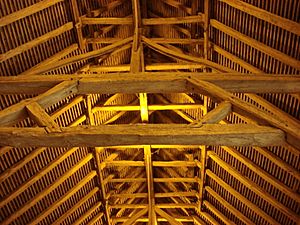Cressing Temple facts for kids
Cressing Temple is a very old place located in Essex, England. It sits between the towns of Witham and Braintree. This site was one of the first and biggest properties owned by the Knights Templar in England. Today, you can visit Cressing Temple and explore its history.
This important site is protected as an ancient monument. The Knights Templar built two large barns here. These barns are now Grade I listed, meaning they are very important historic buildings. One of them is even thought to be the oldest standing timber-framed barn in the world!
Contents
Discovering the Knights Templar at Cressing
How Cressing Temple Became a Templar Home
The land of Cressing was given to the Knights Templar in 1136. This gift came from Matilda of Boulogne, who was the wife of King Stephen. Cressing was a great location because it was near important roads. These roads connected London to Colchester and Witham to Braintree.
This made Cressing Temple one of the very first Templar estates in England. It was also the largest of their properties in Essex. The Templars received more land over time. For example, King John confirmed their ownership of land at Berecholt in 1199. He also gave them land at Newland in 1214.
Life and Work at the Templar Manor
Cressing Temple was a huge farm, covering about 1,400 acres. It was run by a Templar leader called a Preceptor. He worked with a few knights or sergeants, a chaplain, and many servants. About 160 tenant farmers also worked the land.
The manor had many buildings needed for farming and daily life. There was a main house, a bakery, and a place to make drinks. It also had a dairy, a granary for storing grain, and a blacksmith's shop. There were gardens, a dovecote for pigeons, and both a watermill and a windmill. The site even had its own chapel and cemetery. All the money earned from Cressing Temple helped fund the Templars' activities in the Crusader states in the Middle East.
Later, during the time of King Edward II, the Knights Templar order was closed down in England.
Cressing Temple After the Templars
The Knights Hospitaller Take Over
After the Knights Templar were disbanded, Cressing Temple was given to another group. This was the Order of the Knights Hospitaller in 1309. They kept all the Templar documents and records from Cressing. The manor continued to operate as a large farm, managed by a prior of the Knights Hospitaller.
Challenges and Changes at Cressing
In 1381, during the Peasants' Revolt, Cressing Temple was attacked. Rebels took armor, valuable items, and burned books belonging to the Hospitallers. Later, in England, King Henry VIII took almost all the property belonging to the Knights Hospitaller.
Cressing Temple was taken by the King in 1540. This happened soon after many monasteries were closed. In 1541, King Henry VIII gave the manor of Cressing to Sir William Huse and John Smyth. The Smyth family owned the manor until 1657.
After the Reformation, a large house called the 'Great House' stood on the site. However, it was torn down in the 1700s. Today, only the farmhouse, granary, wagon lodge, and stable yards remain. The Tudor brick garden from the mid-1500s is also still there. Essex County Council bought the barns in 1987. They have worked to improve and develop the site for everyone to enjoy.
Cressing Temple Barns: Ancient Wonders
Cressing Temple is famous for its two amazing timber-framed barns. These are the Barley Barn and the Wheat Barn. A historian named Michael Haag called them "the two finest Templar-built barns in Europe." There is also the Granary building, which was built later. Today, you can visit these buildings and the beautiful Tudor gardens.
The Barley Barn
The Barley Barn was built around 1220. It is an early 13th-century building that was changed a bit over the years. This barn is considered the oldest standing timber-framed barn in the world. Its roof was originally covered with tiles, which would have weighed nearly 70 tonnes!
The Wheat Barn
The Wheat Barn was built around 1280. It was also changed in the early 1500s and 1700s. Both the Barley Barn and the Wheat Barn are Grade I listed buildings.
The Granary
The Granary was built after 1575. It is the largest granary in all of Essex.
Tudor Gardens: A Step Back in Time
A walled garden at Cressing Temple has been rebuilt to look like a real Tudor garden. This beautiful garden is now open for visitors to explore.



